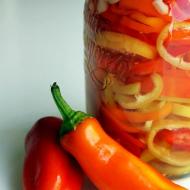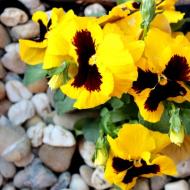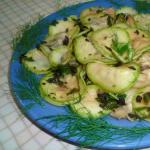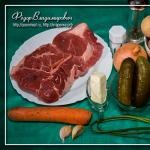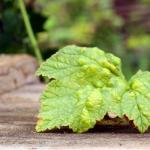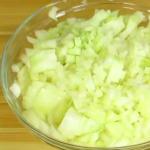
What's wrong with potatoes? Save the harvest!
Read: 366
How to save the potato crop in case of disease! Description of the main potato diseases and measures to combat them.
late blight
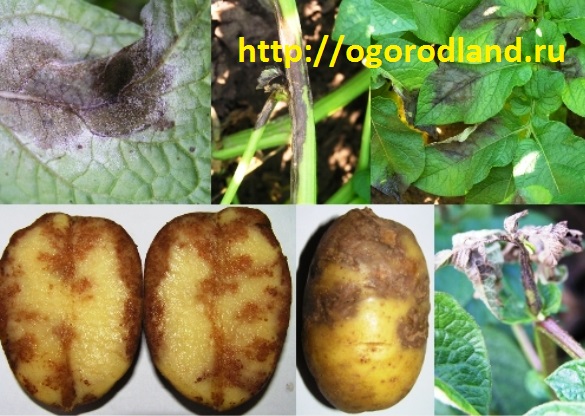
It affects leaves, stems, tubers. Grayish or dark brown spots appear on the lower leaves of the bush. On the underside of the affected leaves, a white fluffy coating is formed, which is a sporulation of the fungus. On the stems and petioles of the leaves, the disease manifests itself in the form of brown stripes. Slightly depressed, sharply defined brown spots are formed on the tubers, penetrating into the pulp in the form of light brown smudges or stripes. Such tubers are not preserved, they rot.
Control measures.
- Cleaning and destruction of affected plant residues;
- Timely and deep hilling;
- Mowing and destruction of the affected tops before harvesting (10-12 days in advance).
- After harvesting the potatoes and before laying them in storage, the tubers must be carefully sorted and sorted.
- After 15-18 days, the selected and dried tubers should be carefully reviewed again.
- In the period from budding to the beginning of the flowering of potatoes, the first spraying of plants is carried out with a 1% solution of Bordeaux mixture (50 g of copper sulfate and 50 g of lime per 10 l of water), solution drug (40 g per 10 liters of water). Consumption of 1 liter of working solution per 10 m 2.
Early dry spotting
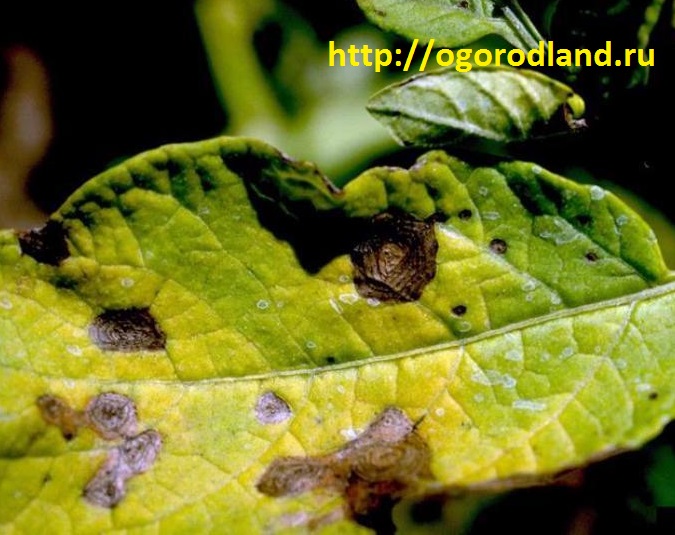
Leaves and stems are affected. Rounded-angular spots form on the leaves. The disease develops rapidly, and after 12-14 days the spots merge. The leaves become fringed, dry out. The spots on stems and petioles are elongated. Affected tops dry out long before the end of the growing season.
Control measures. (See: Potato late blight.)
common scab

Common scab. Appears on tubers in the form of convex sores. (Click to enlarge)
It appears on the tubers in the form of convex sores. During storage, the sores quickly spread throughout the tuber and severely damage the eyes. As a result, the tubers are almost completely unsuitable for planting, as they do not sprout. And if some eyes germinate, they give weak sprouts, which leads to a low yield of potatoes.
Control measures.
- It is impossible to make fresh cow dung for planting potatoes. It is more useful to apply manure humus in the spring.
- If gardeners noticed slight damage to the tubers by scab and planted them in the garden, then it is necessary during flowering, when tuberization occurs, it is good to water the plants with water. Scab quickly infects tubers. If the soil reaction is close to alkaline (pH above 7.0), then to increase the acidity of the soil, ammonium sulfate must be added (2 tablespoons per 10 liters of water), spending 0.5 liters of solution under each bush. Watering is carried out during flowering.
- You can not make fluffy lime, dolomite flour or chalk before planting potatoes.
Blackleg

This is a bacterial disease that starts at the roots and spreads to the bottom of the stems. Signs of this disease are wilting of young tops, twisting and yellowing of leaves. Sick plants are easily pulled out of the soil, their stems are rotten, black. The disease is transmitted by tubers, which are often infected in the fall by contact with affected leaves during potato harvest.
Control measures.
- Sick plants are removed from the site, and the place is dusted with a mixture of ash and copper sulfate (1 tablespoon of copper sulfate per liter jar of ash).
- Before the first hilling, potato plants are fed with a solution of the Barrier preparation (5 tablespoons per 10 liters of water), spending 0.5 liters of solution per plant.
- Sick plants, as well as all tops after harvesting, are burned.
- The dug out tubers must be thoroughly dried and sorted out before being stored.
This disease spreads on gray, cold soils, with frequent rains and low temperatures.
Viral diseases

Virus diseases of potatoes. (Click to enlarge)
With these diseases, the leaves curl and wrinkle, their color becomes yellow-green, the plants lag behind in growth, often die, the tubers are small, ugly, there are few of them in the nest.
Control measures.
- Healthy planting material must be used.
- Seen infected plants should be destroyed (burned) immediately.
- Since viral diseases are transmitted to healthy plants through sucking, chewing insects, they must be destroyed.
ring rot
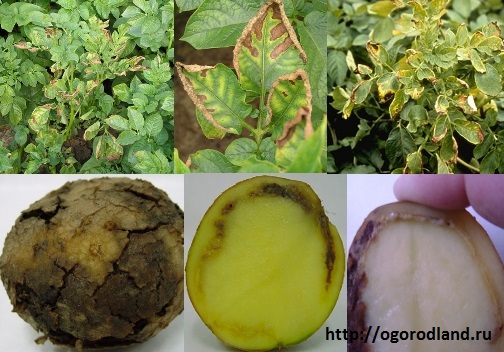
A disease caused by bacteria. With this disease, leaves, stems wither, in a cut tuber you can see infected yellowish areas, which eventually form a continuous ring of rot. The yellowish color becomes gray, and the flesh of the tubers darkens. The disease spreads rapidly if potatoes are harvested in rainy weather.
Control measures.
- It is necessary to plant healthy, germinated tubers;
- Bushes with signs of this disease are removed, and the places are treated with a solution of copper sulfate (60 g per 10 liters of water), spending 1 liter of solution per 5 m 2.
Dry rot
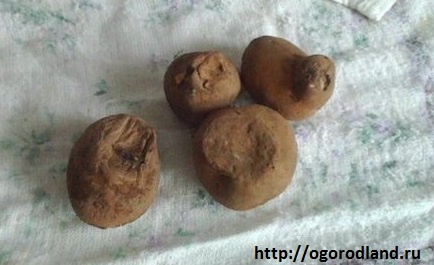
Dry rot - tubers become like dry stone. (Click to enlarge)
A disease caused by a fungus (Fusarium) develops on tubers during storage of potatoes, affects damaged and late blight-infected tubers. Dark-colored spots appear on them, the peel on the spots becomes wrinkled, small pink, white, greenish pads form on the surface, the disease develops especially strongly at high temperatures. The affected parts of the tuber become like a dry stone.
Control measures.
- To prevent the appearance of dry rot, storage is required;
- Prevention of mechanical damage to tubers during harvesting;
- Fight against diseases and pests during the growing season;
wet rot
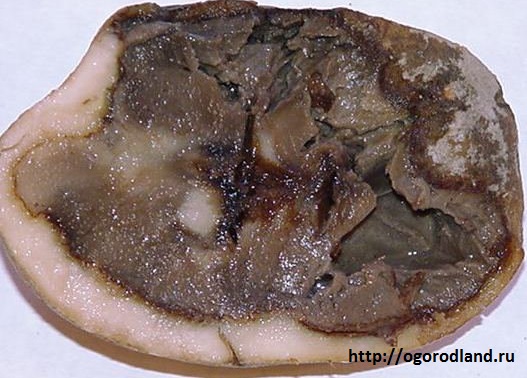
A disease caused by bacteria that settle on tubers damaged by frost or sunlight.
At the same time, the tubers quickly rot, darken, emit an unpleasant odor. The disease progresses strongly at high (20-25°C) temperatures during storage.
Control measures.
- Reduce the temperature in potato storage areas;
- Remove all diseased tubers;
- Sprinkle the remaining tubers with ashes;
- To reduce humidity, put filled boxes with quicklime, ventilate the room.
Bacterial Rot (Potato Mucus Disease)
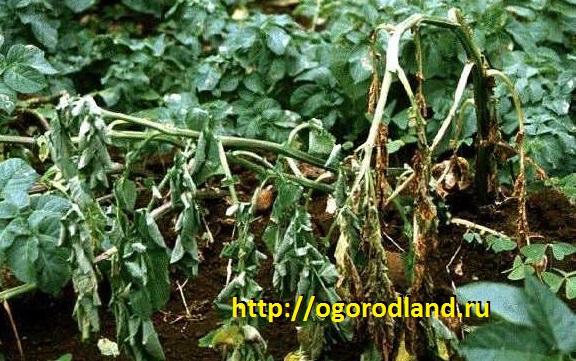
It manifests itself in the flowering phase in the form of tying leaves and stems on sunny days. Withering leaves turn yellow and wrinkle, and leaf petioles and stems droop. Affected stems turn brown, the lower basal part softens and rots, splitting along the stem is observed.
Control measures.
- Rotation of crops;
- Destruction of plant residues after harvesting potatoes and weeds during the growing season of plants;
- Use for seeds only healthy and whole tubers;
- Removal of diseased plants from crops along with tubers.
- Processing potatoes before flowering with the Hom preparation (40 g per 10 l of water), one of the solutions is consumed per 100 m².
Great( 0 ) Badly( 0 )


